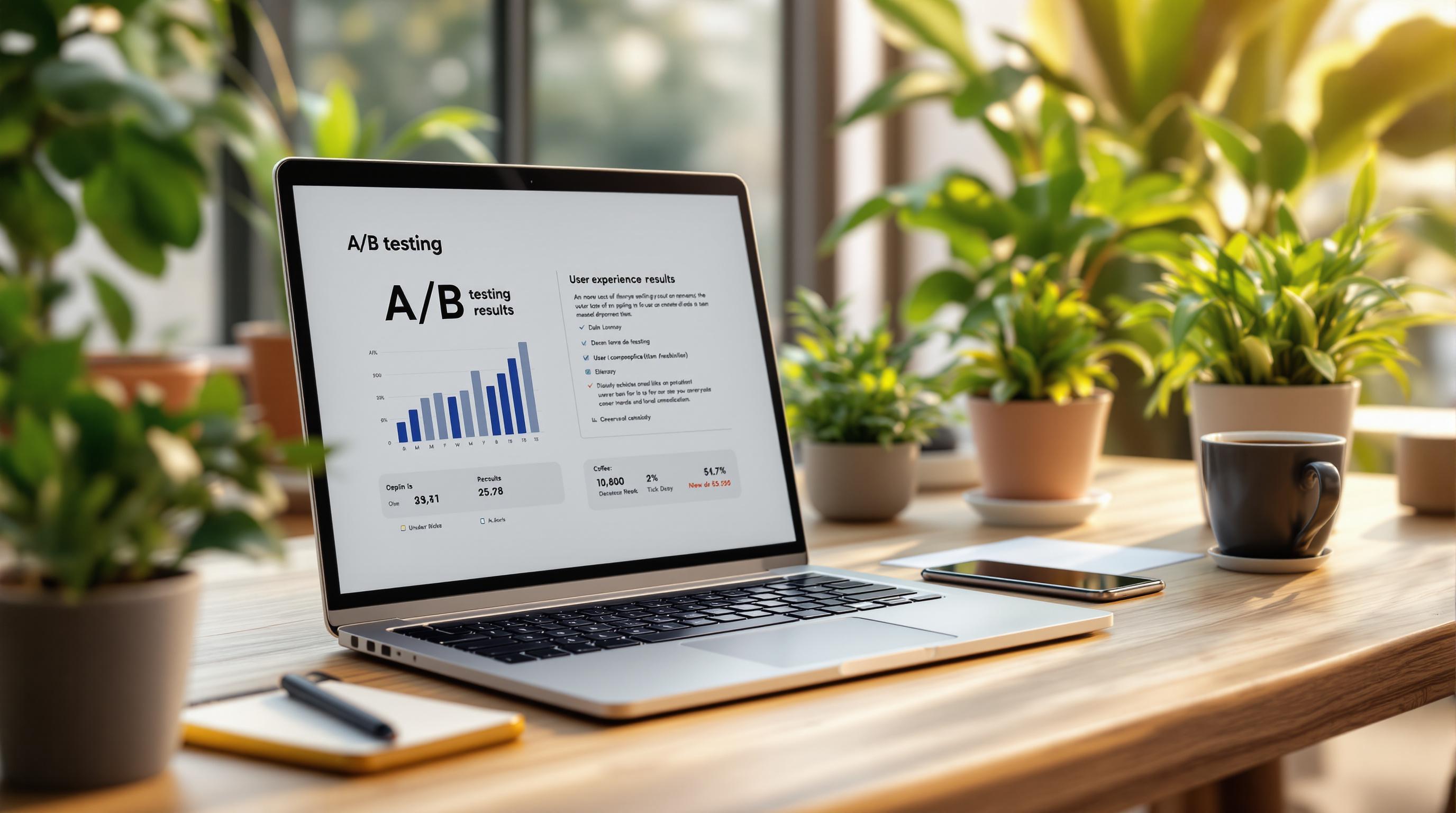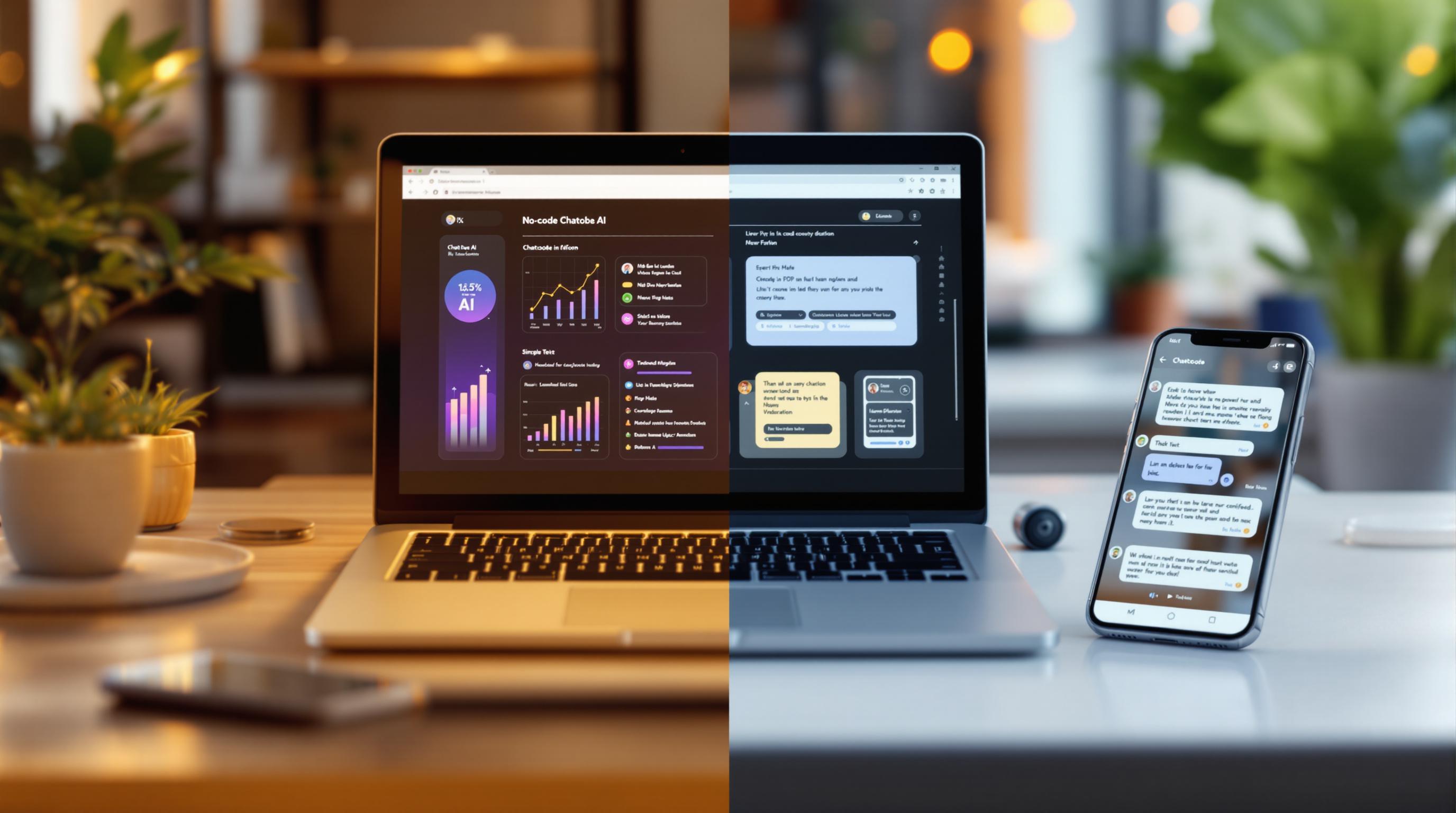Want to boost conversions without writing a single line of code? A/B testing is the answer. With no-code platforms, anyone can test website changes and make data-driven decisions - no developers needed.
Here’s how to do it in 5 simple steps:
- Set Goals: Define clear, measurable objectives like increasing click-through rates by 10%.
- Choose a Tool: Use no-code platforms with drag-and-drop editors and real-time analytics.
- Create Variations: Test one change at a time - like button color or headline text.
- Run Tests: Split traffic evenly (e.g., 50/50) and collect enough data for accurate results.
- Analyze Results: Focus on metrics like bounce rates and conversions to make informed updates.
Why it works: No-code platforms let you test faster, collaborate better, and save on development time. Start small, measure success, and scale your efforts for maximum impact.
How To Set Up An A/B Test In 5 Minutes
Step 1: Set Testing Goals
Clear and measurable goals are the backbone of successful A/B testing. In fact, data from Convert.com shows that companies with well-defined testing goals are 23 times more likely to acquire customers effectively compared to those without structured objectives.
Choose Your Metrics
Picking the right metrics means aligning your testing objectives with your business goals. Here are some popular frameworks to guide your metric selection:
| Framework | Key Metrics |
|---|---|
| HEART (User Experience) | Happiness, Engagement, Adoption, Retention, Task Success |
| AARRR (User Journey) | Acquisition, Activation, Retention, Referrals, Revenue |
| North Star (Primary Focus) | One primary company-wide metric |
Focus on both primary metrics (like conversion rates, which directly measure success) and secondary metrics (like bounce rates, which provide valuable context). This combined approach ensures you get a full picture of your test's impact.
"The best AB testing metrics are the ones that align with your business goals. Understanding and selecting the right A/B testing metrics and using them together is crucial for driving meaningful business impact." - Convert.com
Define Success Criteria
Set SMART goals - Specific, Measurable, Achievable, Relevant, Time-bound - to outline clear success criteria. For instance, you might aim to "increase checkout rates by 15% within 4 weeks."
Key elements for defining success include:
- Statistical Significance: Decide on the minimum sample size needed for reliable results.
- Test Duration: Establish a timeframe that allows for meaningful data collection.
- Improvement Targets: Specify numerical goals, like a percentage increase or decrease.
Don't forget to monitor guardrail metrics. These help ensure that while you're improving one area, you’re not unintentionally harming another. Stick to metrics that directly tie to revenue or user satisfaction, and avoid tracking too many at once - simplicity is key.
Step 2: Pick Your Testing Tool
Choosing the right no-code A/B testing platform can make a big difference in your results. Recent studies show that companies using well-suited testing tools achieve up to 23% better conversion rates compared to those relying on basic or ill-fitting options.
Key Features to Look For
When comparing no-code A/B testing platforms, focus on these important features:
| Feature | What It Offers | Why It Matters |
|---|---|---|
| Visual Editor | Drag-and-drop tools | Easily create variations |
| Test Management | Traffic allocation, goal tracking | Run tests smoothly |
| Analytics | Real-time reporting, analysis | Measure performance |
| Integration | Connect with analytics and CRM | Simplify workflows |
| Security | GDPR, HIPAA compliance | Keep user data safe |
"The effectiveness of an A/B testing tool often depends on how well its features align with your specific goals and needs." - Source Author, Title
Core Principles for Success
Wrapifai highlights two important principles for A/B testing success:
- Visual Building: Easily design and tweak elements without needing technical skills.
- Performance Monitoring: Track user behavior and engagement in real time.
Look for tools that directly support your testing objectives, like traffic management or detailed analytics. Many platforms offer free trials, so take advantage of those to test their usability and features.
Once you've picked your tool, you're ready to start designing the variations for your test.
Step 3: Create Test Versions
Designing test variations is a key part of successful A/B testing. Thanks to modern no-code platforms, you can create and launch these versions without needing to write any code.
Using Visual Editors
Visual editors simplify the process with drag-and-drop functionality. These WYSIWYG (What You See Is What You Get) tools let you make changes directly on the page, so you can see exactly how they’ll appear to users.
Here are some elements you can tweak:
- Headlines: Experiment with 2-3 versions by editing the text directly.
- Images: Drag and drop new images while keeping dimensions consistent.
- Buttons: Change colors or text, but stick to one adjustment at a time.
- Layout: Use grid-based editors to rearrange elements while keeping navigation intuitive.
"Optimize site conversion without writing a single line of code. Taplytics enables you to run more experiments without requiring any development resources." - Shirley Javier, Product Manager, Taplytics [2]
Test Design Guidelines
To get valuable insights, your test versions should align with the goals you set earlier. Follow these key tips when designing variations:
- Focus on One Change at a Time: Adjust only one element per test. For example, if you’re testing a call-to-action button, change either the color OR the text - not both at once.
- Make Noticeable Changes: Test bold differences, like switching to contrasting colors or introducing new messaging, rather than minor tweaks.
- Ensure Mobile Compatibility: Use device previews to confirm that your variations work well on mobile screens.
To stay organized and track your progress, consider:
- Taking screenshots of each version.
- Documenting specific changes and your hypothesis.
- Predicting how user behavior might shift.
Always preview your variations across multiple browsers and devices to ensure they look consistent. While testing bold ideas, make sure your changes still align with your brand’s identity.
Once your variations are finalized, you’re ready to implement and run the test to gather actionable data.
sbb-itb-c495ab1
Step 4: Run Your Test
After crafting your test variations, it's time to launch your A/B test using your selected no-code platform. This stage demands careful attention to traffic distribution and proper setup to ensure your results are reliable.
Setting Up Your Test
A 50/50 traffic split between your control and test versions is the standard approach for most A/B tests. Stick to best practices for test duration, traffic allocation, and sample size to achieve accurate insights. Running your test for 7-14 days typically provides enough time to observe consistent patterns, with a goal of at least 100 conversions per variation for meaningful data.
Once you've finalized the test parameters, the next step is to integrate and deploy the test on your website.
Adding the Test to Your Website
No-code platforms make the process straightforward with user-friendly visual interfaces. For instance, VWO allows both technical and non-technical users to set up and launch tests using its visual editor - no coding required [4].
Here’s how to get started:
- Integrate the platform with your site: Set up success metrics directly in the platform's dashboard.
- Preview your variations: Check how they appear across different devices and connect your analytics tools for detailed tracking.
Some platforms, like Wrapifai, come with built-in performance monitoring tools. These features let you track the progress of your test in real time while ensuring it doesn’t negatively affect your website’s performance.
Once your test is live, you’ll focus on monitoring the results and using the data to guide your next steps.
Step 5: Review and Improve
After running your A/B test, the next step is to analyze the data and use it to make meaningful updates to your website. This is where raw numbers turn into actions that enhance the user experience.
Understanding Test Results
To ensure your results are reliable, aim for a 95% confidence level. This helps confirm that the differences you observe aren’t due to chance. When reviewing your data, focus on these important metrics:
| Metric Type | What to Measure | Why It Matters |
|---|---|---|
| Engagement | Click-Through Rate | Indicates user interaction |
| User Behavior | Bounce Rate | Shows content relevance |
| Performance | Page Load Time | Reflects technical efficiency |
| User Journey | Navigation Patterns | Helps improve overall flow |
"The key to successful A/B testing is not just running tests, but also interpreting the results and making data-driven changes." - Shirley Javier, Product Manager at Taplytics [2]
Once you’ve reviewed the data, it’s time to turn those findings into actionable steps.
Turning Insights Into Changes
Use your test results to make targeted updates by following these steps:
- Understand audience reactions: Identify how different user groups responded to the variations you tested. This helps you focus on what resonates most with specific audiences.
- Document everything: Keep a detailed record of your hypotheses, methods, results, and recommendations. This will guide future decisions.
- Roll out updates gradually: Implement changes step by step to track their impact and ensure they’re working as intended.
Leverage no-code platforms with built-in analytics to monitor results in real time. These tools can help confirm whether your updates are delivering the outcomes you’re aiming for.
Don’t forget to account for external factors like seasonal trends or ongoing marketing campaigns. These can influence user behavior and should be part of your analysis.
Conclusion
Key Steps Recap
A/B testing without code is now easier than ever, thanks to modern no-code platforms. The five-step process outlined below offers a straightforward way to make data-driven decisions and improve your digital efforts.
| Step | Focus Area | Key Consideration |
|---|---|---|
| Goal Setting | Define success metrics | Align with business goals |
| Tool Selection | Pick user-friendly platforms | Verify integration options |
| Version Creation | Create test variations | Change only one variable at a time |
| Test Execution | Run and monitor tests | Ensure test accuracy |
| Results Analysis | Analyze outcomes and apply changes | Strive for a 95% confidence level |
These steps provide a clear path to start optimizing your digital presence.
How to Begin
Take the first step by starting small and setting clear objectives. This approach will help you make smarter, data-backed decisions to improve user experiences. As Brian Massey, Conversion Scientist™ at Conversion Sciences, puts it: "By leveraging A/B testing, you can make informed decisions, improve user experiences, and ultimately drive business growth through data-backed optimizations" [1].
For your first test, focus on:
- Defining measurable goals that align with your business priorities.
- Choosing a testing platform that suits your needs.
- Remember: A/B testing landing pages has been shown to boost leads by up to 40% [3].
FAQs
How to make AB tests?
Running A/B tests without coding is easier than you might think. Follow these steps to get started:
| Step | Key Action | Best Practice |
|---|---|---|
| Goal Setting | Define specific metrics | Focus on one main metric, like conversion rates or click-through rates |
| Tool Selection | Pick a visual editor platform | Choose tools that align with your testing needs |
| Test Creation | Create variations | Adjust only one element per test to isolate its impact |
| Analysis | Track results | Look for a confidence level of 95% or higher to ensure reliable insights |
Modern platforms make testing smoother by offering features like:
- Real-time monitoring: Keep an eye on how your test performs as it happens.
- All-in-one tools: Use platforms that combine visual editing and goal tracking for a more streamlined process.
To ensure accuracy, let your test run long enough to collect enough data. Statistical tools can help you figure out the right duration for dependable results.


